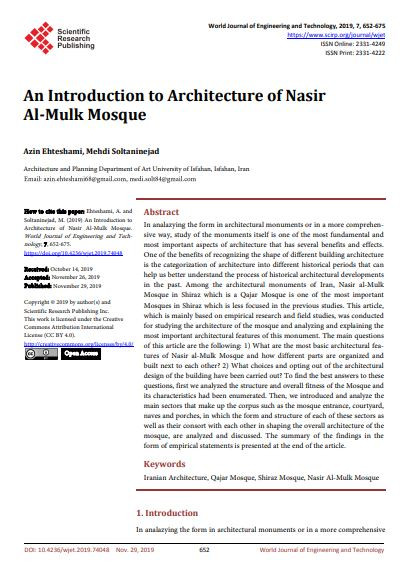
Nasir Al-Mulk Mosque, famously known as the Pink Mosque, is a traditional mosque located in the Gawd-i Arabān quarter of Shiraz, Iran, near the Shāh Chérāgh Mosque. Constructed during the Qajar dynasty, it is one of the most visually striking mosques in Iran, celebrated for its unique use of color, light, and intricate design elements.
While the mosque’s exterior resembles many classical Islamic structures—with its pointed arches and modest brickwork—the interior reveals a breathtaking masterpiece of Persian architecture. The mosque is best known for its extensive use of colored glass, particularly stained glass windows that fill the space with a kaleidoscope of light during the early morning hours. The sunlight, passing through these vibrant panels, casts vivid, shifting patterns on the Persian carpets and tiled floors, creating a surreal and meditative atmosphere.
Nicknamed the “Pink Mosque” due to the dominant use of pink-colored tiles in its interior, the building also incorporates traditional Persian elements such as Panj Kāse (five concaved ceiling designs), muqarnas, and highly detailed Quranic inscriptions carved into walls and ceilings. Ornate arches, elegant chandeliers, and delicate tile mosaics enhance the visual complexity of the space, while fine Persian carpets add warmth and texture.
The spatial design of the mosque draws heavily from traditional Islamic architectural concepts. A key feature is the Shamseh pattern, developed from two overlapping squares—one aligned with the Qiblah (the direction of Mecca), and the other organizing the mosque’s spatial layout. This geometric and symbolic layering reflects a deep understanding of form, orientation, and spiritual purpose.
The mosque’s design methodology follows an inductive architectural approach, combining traditional Islamic elements with experimental and contemporary interpretations. This innovative integration allows the Nasir al-Mulk Mosque to stand out not only for its beauty but also as a creative exploration of sacred space in Islamic architecture.
Today, the Pink Mosque remains one of Shiraz’s most admired monuments, drawing visitors from around the world for its serene, light-filled interiors and intricate craftsmanship.
Disclaimer : Mopsqpedia is a non-profit database. All images featured in the database are sourced from various references, publications, and websites related to mosque architecture. Mosqpedia does not claim ownership of any images unless explicitly stated. Images are provided solely for educational and bibliographic purposes. Mosqpedia disclaims any responsibility for copyright infringements related to the images displayed. Users are responsible for verifying copyright status and obtaining permission from original sources if they intend to reproduce, distribute, or use any image beyond fair use.
I agree to the terms outlined below:
You agree to upload and assign Mosqpedia Database the rights to use the content worldwide and in perpetuity across all current and future media platforms. Mosqpedia Database may edit, copy, adapt and translate your contribution.
The content will be distributed under the Creative Commons Attribution-Deed – Attribution-NonCommercial-NoDerivatives 4.0 International – Creative Commons
All data will be stored in line with data protection regulations.
I agree to the terms outlined below:
You agree to upload and assign Mosqpedia Database the rights to use the content worldwide and in perpetuity across all current and future media platforms. Mosqpedia Database may edit, copy, adapt and translate your contribution.
The content will be distributed under the Creative Commons Attribution-Deed – Attribution-NonCommercial-NoDerivatives 4.0 International – Creative Commons
All data will be stored in line with data protection regulations.